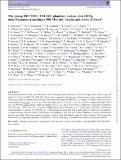The young HD 73583 (TOI-560) planetary system: Two 10-M⊕ mini-Neptunes transiting a 500-Myr-old, bright, and active K dwarf
Author(s)
Seager, Sara
DownloadPublished version (6.266Mb)
Publisher with Creative Commons License
Publisher with Creative Commons License
Creative Commons Attribution
Terms of use
Metadata
Show full item recordAbstract
<jats:title>ABSTRACT</jats:title><jats:p>We present the discovery and characterization of two transiting planets observed by TESS in the light curves of the young and bright (V = 9.67) star HD73583 (TOI-560). We perform an intensive spectroscopic and photometric space- and ground-based follow-up in order to confirm and characterize the system. We found that HD73583 is a young (∼500 Myr) active star with a rotational period of 12.08 ± 0.11 d, and a mass and radius of 0.73 ± 0.02 M⊙ and 0.65 ± 0.02 R⊙, respectively. HD 73583 b (Pb = $6.3980420 _{ - 0.0000062 } ^ { + 0.0000067 }$ d) has a mass and radius of $10.2 _{ - 3.1 } ^ { + 3.4 }$ M⊕ and 2.79 ± 0.10 R⊕, respectively, which gives a density of $2.58 _{ - 0.81 } ^ { + 0.95 }$ ${\rm g\, cm^{-3}}$. HD 73583 c (Pc = $18.87974 _{ - 0.00074 } ^ { + 0.00086 }$ d) has a mass and radius of $9.7 _{ - 1.7 } ^ { + 1.8 }$ M⊕ and $2.39 _{ - 0.09 } ^ { + 0.10 }$ R⊕, respectively, which translates to a density of $3.88 _{ - 0.80 } ^ { + 0.91 }$ ${\rm g\, cm^{-3}}$. Both planets are consistent with worlds made of a solid core surrounded by a volatile envelope. Because of their youth and host star brightness, they both are excellent candidates to perform transmission spectroscopy studies. We expect ongoing atmospheric mass-loss for both planets caused by stellar irradiation. We estimate that the detection of evaporating signatures on H and He would be challenging, but doable with present and future instruments.</jats:p>
Date issued
2022Department
Massachusetts Institute of Technology. Department of Earth, Atmospheric, and Planetary SciencesJournal
Monthly Notices of the Royal Astronomical Society
Publisher
Oxford University Press (OUP)
Citation
Seager, Sara. 2022. "The young HD 73583 (TOI-560) planetary system: Two 10-M⊕ mini-Neptunes transiting a 500-Myr-old, bright, and active K dwarf." Monthly Notices of the Royal Astronomical Society, 514 (2).
Version: Final published version